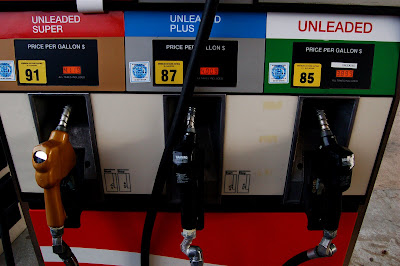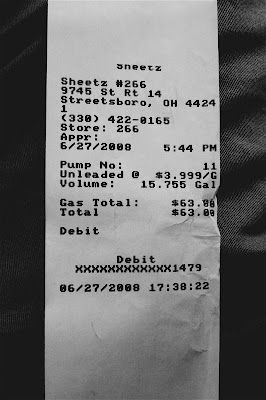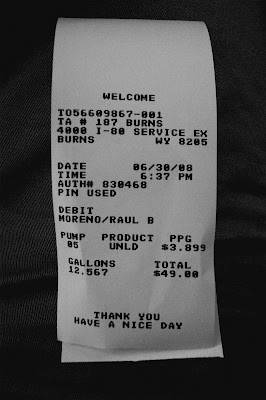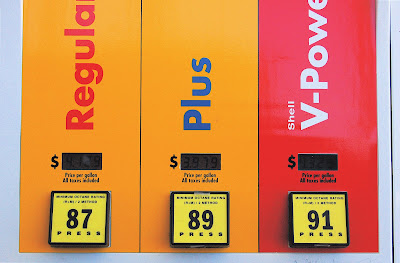Over the past several days I have been driving a 2008 Kia Sedona halfway across the continent, from Washington, D.C. to Fort Collins, Colo. After losing public radio, somewhere in Ohio, I began pulling out my camera during stops for gas. The pictures aren't pretty.

Unleaded gas now averages $4.07 per gallon in the U.S.
My rented van has dual-sliding doors, foldaway seats, and a V6 engine: perfect for hauling furnishings, but at 16 to 18 miles per gallon, hardly the most economical vehicle for a 1,700-mile road trip. It is, however, the kind of vehicle routinely drawing $60.00 or more from middle-income American families needing a fresh tank of gas.

Nationally, fewer consumers are buying premium gas than they have in nearly a quarter century
Petroleum prices are so high, warns USA Today, that volunteers are finding rural, elderly residents who have avoided driving into town for months. Nationally, Americans bought about two percent less gas in the last month than they did in the same period last year, NPR reported on Sunday. And The Associated Press points out that demand for premium gas has reached its lowest level in almost 25 years.

TravelCenters of America in Burns, Wyo. offered the trip's cheapest gas
This brings us to a couple of observations about American gas prices. First, the delineations between regular, mid-grade, and premium gas have strayed from what was formerly a hallowed $0.10 margin, advertised on glowing signposts around the country. It was a margin that made for easy mental computations in figuring how much more it would cost to treat one's vehicle to premium-grade fuel. But my father could never fathom why the margin held steady for years at $0.10, despite surges in oil prices. With the cost of a barrel of oil rising ever higher as the margin remained fixed, he reasoned, the difference in the retail value of regular and premium gas would practically disappear.

Ten cent price margins no longer divide regular and premium fuels
Economic forces have apparently won out against marketing departments at major oil companies, because one now sees the margins between fuel grades widening to a curious $0.11 in Burns, Wyo., for example, or as much as $0.14 in Coralville, Iowa.
Gas stations in Iowa and neighboring corn-producing giants like Nebraska pose an additional curiosity, one that found me shaking my head the other day as I realized I was buying regular unleaded from Gasby's BP station in Coralville for more than the price of mid-grade fuel -- a standard $0.10 more, to be exact. Bewildered, I killed the pump, stared hard at the prices, and then switched to BP's cheaper "silver" blend, which carried an octane rating of 89, two points better than regular.

In corn country, an abundance of ethanol seems to make premium fuels like Shell's "Plus" cheaper than regular
"It's because Iowa produces a lot of ethanol," explained a freckled gas attendant behind the counter at Gasby's. "Or at least we did until all these floods came along." (She was referring to the Cedar River and other waterways that have topped historic levels in recent weeks, swamping hundreds of cities in six states and threatening the region's crop yields.)

Americans bought slightly less gas in the last month than they did in the same period last year
I couldn't argue with the attendant's reasoning, and it seemed to be confirmed by a notice posted above the "Plus" pump farther down Interstate 80, at a Shell station in York, Neb.: "THIS PRODUCT CONTAINS TEN PERCENT ETHANOL." At $3.98, well below the national average, one could almost call it cheap gas. At least it was $0.15 cheaper than regular.
